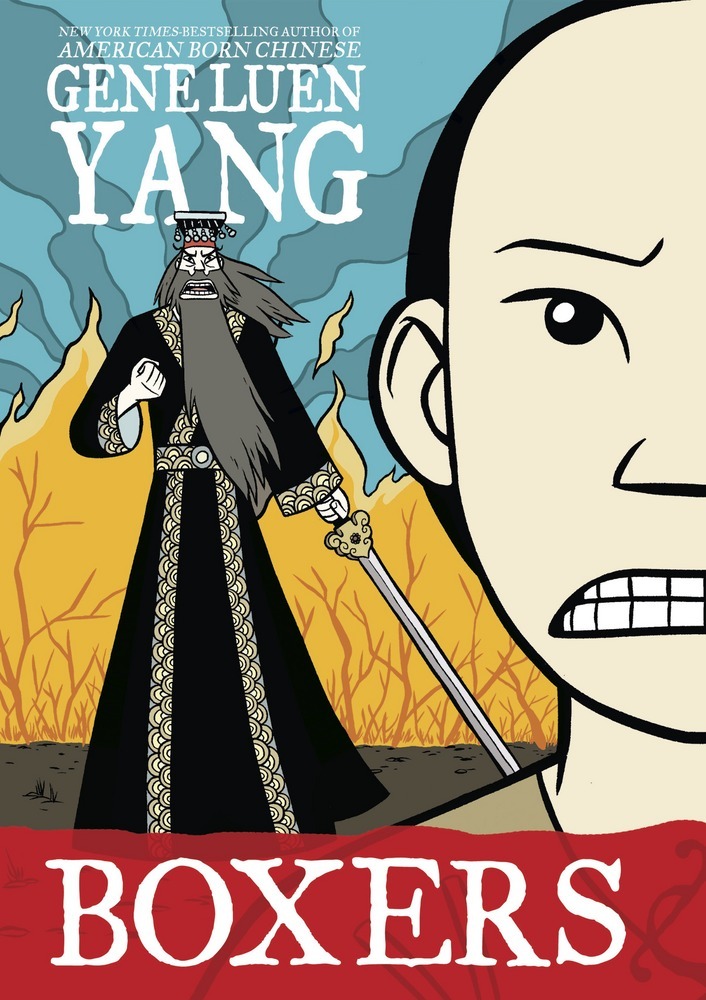
Boxers
Written and illustrated by Gene Luen Yang
First Second, 2013, 336 pp.
ISBN: 978-1-59643-359-5
A troubling time in China, 1894 to 1900, saw severe droughts followed by floods and famine in the Shandong province. Conflicts increased as foreign missionaries spread across China, intimidating the local peasants and attempting to convert them to Christianity. Foreign soldiers increased the suffering of the Chinese people. Little Bao, trained by a Kung Fu master, organizes a group of fighters to rebel against the foreign invaders. Fighting along with his brothers, Little Bao travels through China protecting peasants. Little Bao’s group gains popularity, and is given the title of the Society of the Righteous and Harmonious Fists by the Chinese. The group becomes equally well-known by Westerners who call them the Boxers. These fighters believe that they gain their power from Chinese gods and are convinced they are untouchable by foreign weapons, and therefore indestructible.
Little Bao has many internal conflicts as he tries to follow the edicts the Kung Fu master had taught him, like “Edict # 4: Have compassion for the weak” (p. 151). Later, Little Bao learns that there is no room for compassion in the war as his own brother dies at the hands of a child whose life he spares. Bao grows from a traditional, sympathetic young man into a fighter who is able to commit monstrous acts. Villages and churches are burned by the Society of the Righteous and Harmonious Fists. The Boxers kill everyone who threatens China, including the “secondary devils,” the Chinese who converted to Christianity.
During the years of the Boxer rebellion, Bao gets to know Mei-wen, a young woman who later joins the Boxer rebels and organizes her own society of female fighters. As rebels reach Peking (today’s Beijing), they encounter many Western colonists, foreign soldiers, and Chinese Christians. Eventually, in the name of China, Little Bao burns a church full of Christian women and children. With the support of the Imperial Army, the Boxers make foreigners and Chinese Christians seek refuge in the Legation Quarter. After many days of the siege, the foreigners gain support from their allies, defeat the Boxer rebels, and take back Peking.
Although this graphic novel is reader-friendly and looks like a comic book geared for children, there are parts that are horrifying, like the scene that shows the fate of Red Lantern Chu, the Kung Fu master, whose head is carried on a spike after being beheaded by the Imperial Army. Yang explained that although he wanted to make it easy to read, he used terrifying graphic images and descriptions because he wanted the reader to empathize with Little Bao while demonstrating the struggles that the Chinese people endured in that era (Interview, 2013).
As there are two sides to every story, there are also two sides to the Boxer rebellion. Boxers is the first part of the two-volume project, Boxers & Saints. Yang wrote Saints, the second part of the project, from the view of a young Christian protagonist who fights the Boxers. As Yang stated, “When I looked into the lives of these [recently canonized] saints, I discovered that many of them had been martyred during the Boxer Rebellion. The more I read about the Boxer Rebellion, the more conflicted I felt. Did I sympathize more with the Boxers or their Chinese Christian victims? That’s why the project ended up as two volumes. The protagonists in one are the antagonists in the other” (Interview, 2013). Possible pairing for these two books could include American Born Chinese (Yang, 2007) or books on rebellions or books such as Bull Run (Fleischman, 1995), which also includes a multi-voiced storyline.
Gene Luan Yang grew up in a Chinese-American Catholic community in the San Francisco Bay area. To him, Christianity and Chinese culture seemed to go hand-in-hand, but it was not the same for people in China in the 1900s. “Being a Chinese Christian was seen as a contradiction,” Yang said. “Embracing a Western faith meant turning your back on Eastern culture” (Interview, 2013). An accomplished graphic novelist, Yang wrote this historical fiction also as a graphic novel. However, unlike some of his other published novels, Yang wrote and illustrated Boxers entirely himself in order to control the tone and message of the story. This was important as the violence he was describing was often overwhelming, and he tried to ‘cartoonify’ the scenes in order to, as he put it, “make it more palatable” (Interview, 2013).
Flyura Gasca, Coastal Carolina University
References
Interview: Gene Luen Yang on Boxers & Saints. (2013, September 19). Retrieved from
http://blogs.slj.com/goodcomicsforkids/2013/09/19/interview-gene-luen-yang-on-boxerssaints/
WOW Review, Volume XI, Issue 1 by Worlds of Words is licensed under a Creative Commons Attribution-NonCommercial-ShareAlike 4.0 International License.
Based on a work at http://wowlit.org/volume-xi-issue-1/
